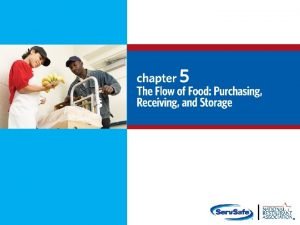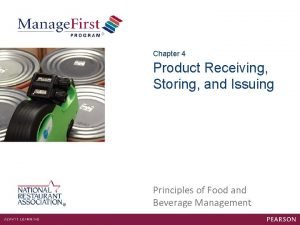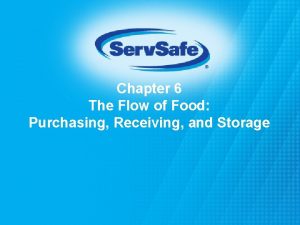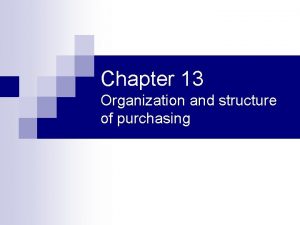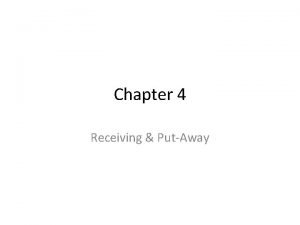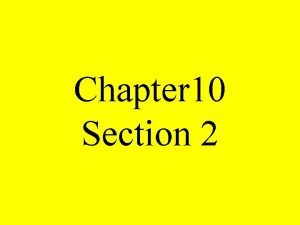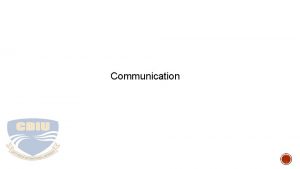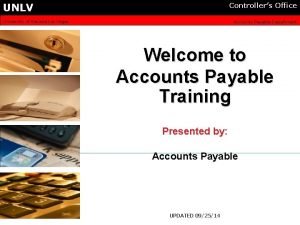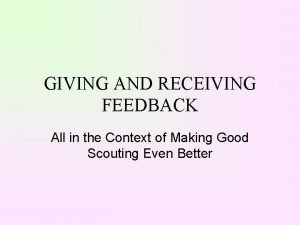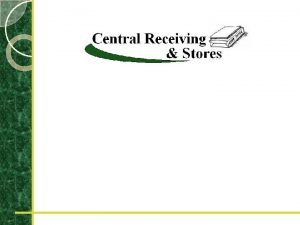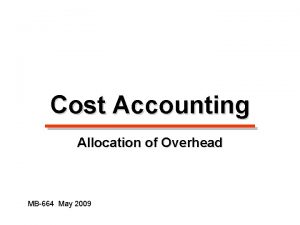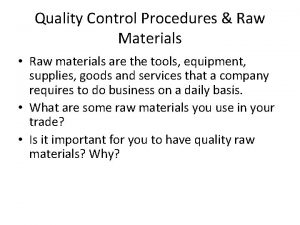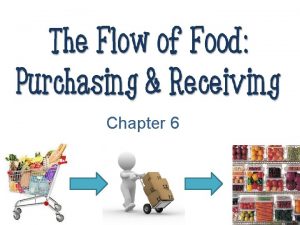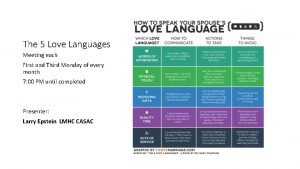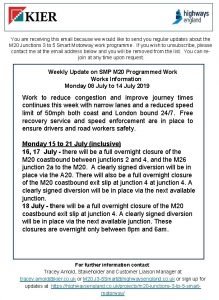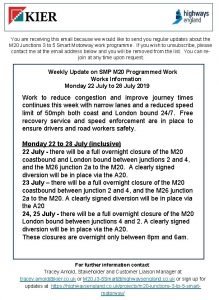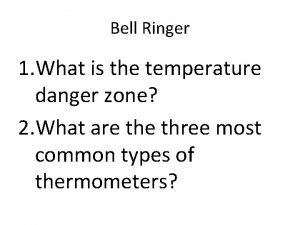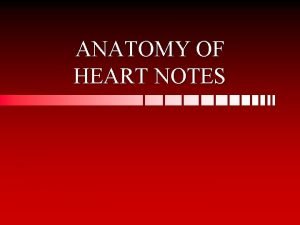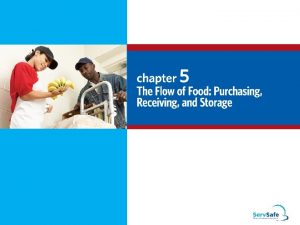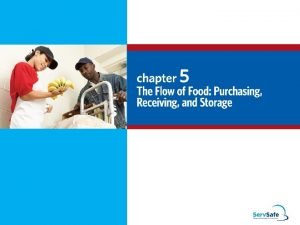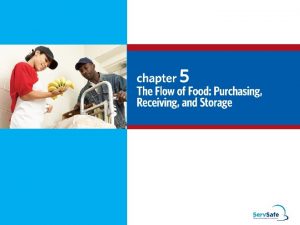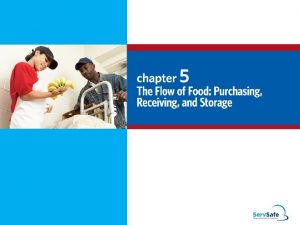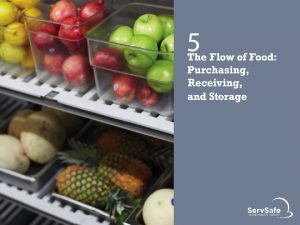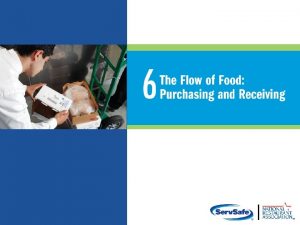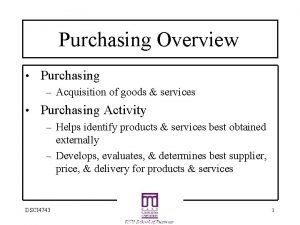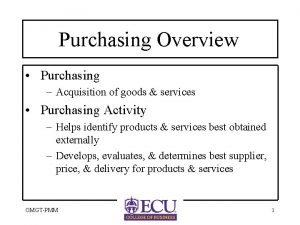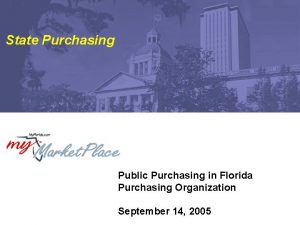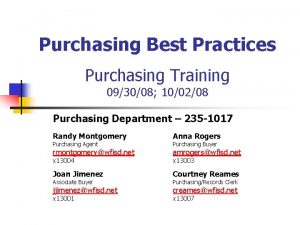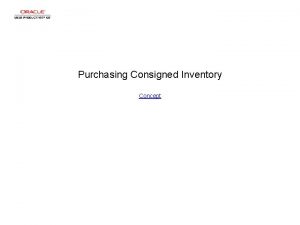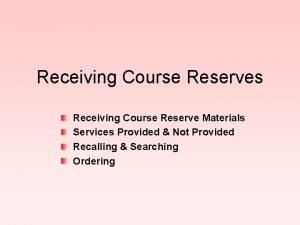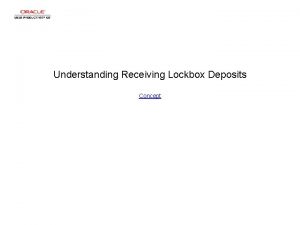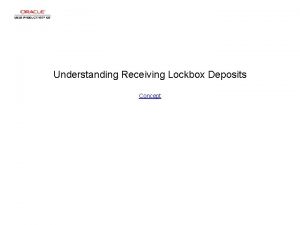Purchasing and Receiving 5 2 General Purchasing and




































- Slides: 36


Purchasing and Receiving 5 -2

General Purchasing and Receiving Principles Purchase food from approved, reputable suppliers: l Have been inspected l Meet all applicable local, state, and federal laws Arrange deliveries so they arrive: 5 -3 l When staff has enough time to do inspections l When they can be correctly received

Receiving and Inspecting Key drop deliveries: 5 -4 l Supplier is given after-hour access to the operation to make deliveries l Deliveries must meet the following criteria: o Be inspected upon arrival at the operation o Be from an approved source o Have been placed in the correct storage location to maintain the required temperature o Have been protected from contamination in storage o Are NOT contaminated o Are honestly presented

Receiving and Inspecting Recalls: 5 -5 l Identify the recalled food items l Remove the item from inventory, and place it in a secure and appropriate location l Store the item separately from food, utensils, equipment, linens, and single-use items l Label the item in a way that will prevent it from being placed back in inventory l Inform staff not to use the product l Refer to the vendor’s notification or recall notice to determine what to do with the item

Would you accept it or reject It? 5 -6

Accept / Reject Criteria Would you accept or reject it? A. Accept B. Reject Meat received at 40ºF (4ºC) 5 -7

Accept / Reject Criteria Would you accept or reject it? A. Accept B. Reject 5 -8 Live oysters received at an internal temperature of 50ºF (10ºC)

Accept / Reject Criteria Would you accept or reject it? A. Accept B. Reject Milk received at 45ºF (7ºC) 5 -9

Accept / Reject Criteria Would you accept or reject it? A. Accept B. Reject Eggs received at an air temperature of 50ºF (10ºC) 5 -10

Accept / Reject Criteria Would you accept or reject it? A. Accept B. Reject Hot TCS food received at 120ºF (49ºC) 5 -11

Accept / Reject Criteria Would you accept or reject it? A. Accept B. Reject Frozen shrimp 5 -12

Accept / Reject Criteria Would you accept or reject it? A. Accept B. Reject Flour 5 -13

Accept / Reject Criteria Would you accept or reject it? A. Accept B. Reject Flour 5 -14

Accept / Reject Criteria Would you accept or reject it? A. Accept B. Reject Danish 5 -15

Accept / Reject Criteria Would you accept or reject it? A. Accept B. Reject ROP meat 5 -16

Accept / Reject Criteria Would you accept or reject it? A. Accept B. Reject Fresh tuna with a seaweed smell 5 -17

Accept / Reject Criteria Would you accept or reject it? A. Accept B. Reject Fresh pork chops that are sticky 5 -18

Receiving and Inspecting Required documents: l 5 -19 Shellfish must be received with shellstock identification tags o Tags indicate when and where the shellfish were harvested o Must be kept on file for 90 days from the date the last shellfish was used from its delivery container

Receiving and Inspecting Required documents: l l 5 -20 Fish that will be eaten raw or partially cooked: o Documentation must show the fish was correctly frozen before being received o Keep documents for 90 days from the sale of the fish Farm-raised fish: o Must have documentation stating the fish was raised to FDA standards o Keep documents for 90 days from the sale of the fish

Storage 5 -21

Storage Labeling food for use on-site: 5 -22 l All items not in their original containers must be labeled l Food labels should include the common name of the food or a statement that clearly and accurately identifies it l It is not necessary to label food if it clearly will not be mistaken for another item

Storage Labeling food packaged on-site for retail sale: 5 -23 l Common name of the food or a statement clearly identifying it l Quantity of the food l If the item contains two or more ingredients, list the ingredients in descending order by weight l List of artificial colors and flavors in the food, including chemical preservatives l Name and place of business of the manufacturer, packer, or distributor l Source of each major food allergen contained in the food

Storage Date marking: l 5 -24 Ready-to-eat TCS food can be stored for only seven days if it is held at 41ºF (5ºC) or lower o The count begins on the day that the food was prepared or a commercial container was opened o For example, potato salad prepared and stored on October 1 would have a discard date of October 7 on the label o Some operations write the day or date the food was prepared on the label; others write the use-by day or

Storage Date marking: If: l A commercially processed food has a use-by date that is less than seven days from the date the container was opened Then: l 5 -25 The container should be marked with this use-by date as long as the date is based on food safety

Storage Date marking: 5 -26 l When combining food in a dish with different use-by dates, the discard date of the dish should be based on the earliest prepared food l Consider a shrimp and sausage jambalaya prepared on December 4 o The shrimp has a use-by date of December 8 o The sausage has a use-by date of December 10 o The use-by date of the jambalaya is December 8

Correct or Incorrect? 5 -27

Correct or Incorrect? Is this a correct or incorrect storage practice? A. Correct B. Incorrect Hanging thermometer in the back of a cooler 5 -28

Correct or Incorrect? Is this a correct or incorrect storage practice? A. Correct B. Incorrect Chicken salad 5 -29

Correct or Incorrect? Is this a correct or incorrect storage practice? A. Correct B. Incorrect It is January 25 th 2011 5 -30

Correct or Incorrect? Is this a correct or incorrect storage practice? A. Correct B. Incorrect The year is 2006 5 -31

Correct or Incorrect? Is this a correct or incorrect storage practice? A. Correct B. Incorrect 5 -32

Correct or Incorrect? Is this a correct or incorrect storage practice? A. Correct B. Incorrect 5 -33

Correct or Incorrect? Is this a correct or incorrect storage practice? A. Correct B. Incorrect 5 -34

Storage Preventing crosscontamination: l Store food items in the following top-to-bottom order: A. Ready-to-eat food B. Seafood C. Whole cuts of beef and pork D. Ground meat and ground fish E. Whole and ground poultry l 5 -35 This storage order is based on the minimum internal cooking temperature of each food

Storage Food should be stored in a clean, dry location away from dust and other contaminants. l 5 -36 To prevent contamination, NEVER store food in these areas: o Locker rooms or dressing rooms o Restrooms or garbage rooms o Mechanical rooms o Under unshielded sewer lines or leaking water lines o Under stairwells
 General receiving principles
General receiving principles Purchasing, receiving, storing, and issuing
Purchasing, receiving, storing, and issuing Servsafe food storage diagram
Servsafe food storage diagram The flow of food purchasing receiving and storage
The flow of food purchasing receiving and storage Purchasing organization structure
Purchasing organization structure Emergency purchasing
Emergency purchasing Batched and sequenced putaway
Batched and sequenced putaway An institution for receiving, keeping and lending money
An institution for receiving, keeping and lending money 5 love languages love tank
5 love languages love tank Communication in general is process of sending and
Communication in general is process of sending and Unlv vendor registration
Unlv vendor registration Giving and receiving feedback by phil rich
Giving and receiving feedback by phil rich Sending and receiving signals are special constructs of
Sending and receiving signals are special constructs of Complex transmitting and receiving unit
Complex transmitting and receiving unit Uncc receiving and stores
Uncc receiving and stores An ordering and receiving materials cost pool
An ordering and receiving materials cost pool It is a very shallow skillet with very short sloping sides
It is a very shallow skillet with very short sloping sides Qc raw materials
Qc raw materials Facegmail
Facegmail What must be done after receiving a key drop delivery?
What must be done after receiving a key drop delivery? Receiving god's gifts life in the spirit seminar
Receiving god's gifts life in the spirit seminar 5 love languages explained
5 love languages explained This section discusses
This section discusses Receiving visitors in the office conversation
Receiving visitors in the office conversation Purchasing in food flow
Purchasing in food flow Christ with the sick around him, receiving the children
Christ with the sick around him, receiving the children You are receiving this email because
You are receiving this email because You are receiving this email because
You are receiving this email because You are receiving this email because
You are receiving this email because Lemon trees receiving the most water
Lemon trees receiving the most water Central receiving hospital
Central receiving hospital Risk of blood transfusion
Risk of blood transfusion Example of receiving in affective domain
Example of receiving in affective domain Learning objective verbs
Learning objective verbs A process of receiving selecting organizing
A process of receiving selecting organizing Receiving temperature of fresh poultry
Receiving temperature of fresh poultry Receiving chambers of the heart
Receiving chambers of the heart
